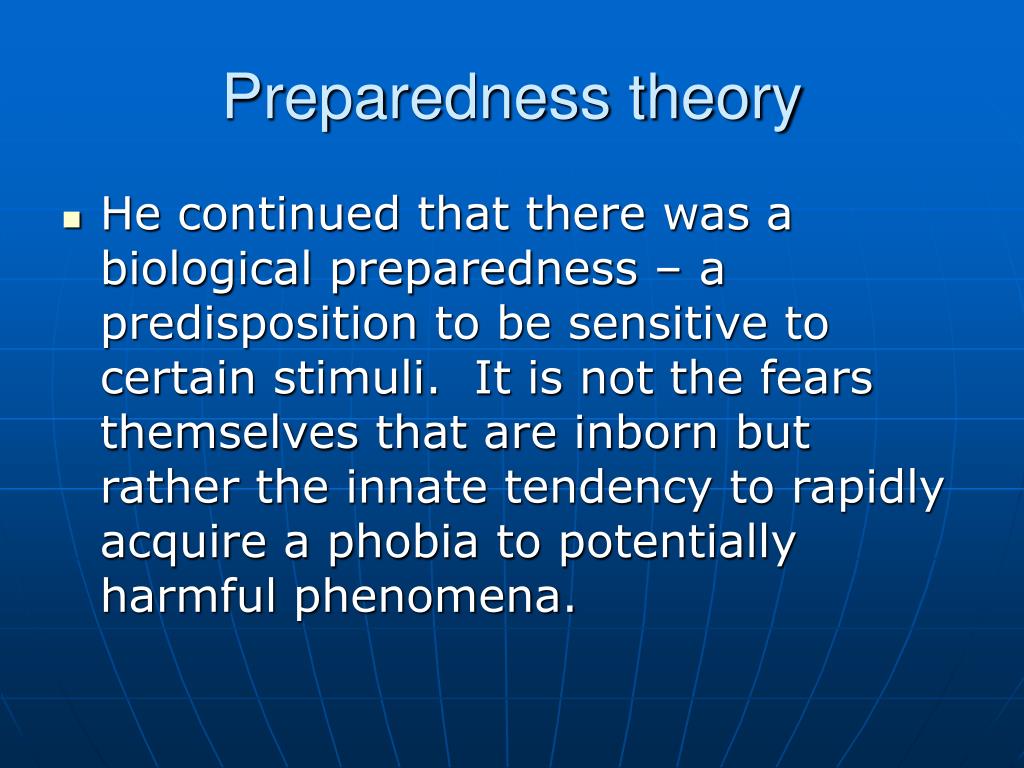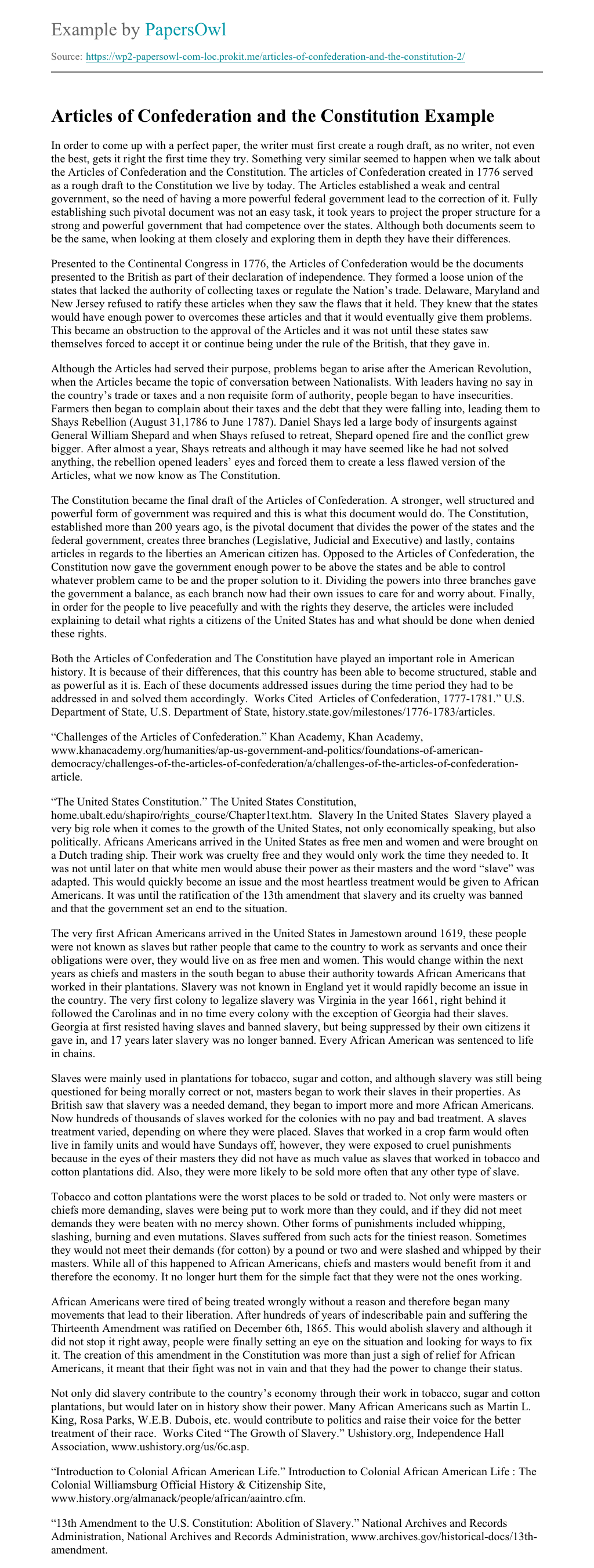Seligman's () classic article, "Phobias and Preparedness," marked a break from traditional conditioning theories of the etiology of phobias, inspiring a line of research integrating evolutionary theory with learning theory. In this article, I briefly sketch the context motivating the preparednes Cited by: 12 Jul 23, · Seligman's preparedness theory says that humans are phylogenetically prepared to fear certain stimuli more than others. Continue reading to find out more about it. Seligman’s preparedness theory explains how phobias are disproportionate fear reactions to harmless stimuli or stimuli that aren’t entirely harmless and controllable Jul 23, · Seligman’s preparedness theory explains how phobias are disproportionate fear reactions to harmless stimuli or stimuli that aren’t entirely harmless and controllable. There are countless theories on how phobias are acquired and maintained, and all of them are partly correct
Seligman’s Preparedness Theory | Chantal MAILLE Praticien en Psychothérapie - Psychanalyste
There are countless theories on how phobias are acquired and maintained, seligmans theory of preparedness, and all of them are partly correct. Preparedness theory explains that people are born ready to fear certain kinds of stimuli more than others, seligmans theory of preparedness. Its two central concepts are preparedness and predisposition for the acquisition of phobias.
Seligman developed his priming theory in response to the equipotentiality theory, which states that all stimuli have the same facility for conditioning. Against this, he states that humans are phylogenetically prepared to fear certain stimuli more than others. This is an evolutionary seligmans theory of preparedness, as a result of the need for organisms to adapt to their environment. Thus, people are more likely to fear dangerous rather than harmless stimuli because it threatens human survival, seligmans theory of preparedness.
Preparedness refers to the evolutionary processes of the species. Thus, there are three types of stimuli depending on how conditioned we are for them:. Likewise, predisposition refers to those characteristics of an individual and their ontogenetic development that make them more prone to experience a phobia. This group extended the priming theory and distinguished phobias according to their phylogenetic or evolutionary origin. It distinguishes between communicative and non-communicative fears.
Non-communicative fears are those that have no social or communicative function. In turn, communicative fears are those with the social function of transmitting messages between species. Moreover, there are animal or interspecific phobias, common to different species, and social or intraspecific phobias within the communicative fears.
Animal fears interspecies originate in the behavioral system of defense against predators and generate avoidance or escape responses triggered by automatic seligmans theory of preparedness. Thus, this response leads to high activation of the sympathetic autonomic nervous system.
Furthermore, social fears intraspecies arise from dominance-submission processes in the context of the same species. Therefore, they involve less automatic, more reflexive processes and produce responses that depend on controlled processes. This effect explains why people reject a type of food that made them sick at some point. This conditioned taste aversion occurs in a single trial or a single occurrence easy acquisition.
Moreover, people maintain it over time the resistance to extinction that Seligman spoke of. Garcia and Koelling found in their research that not all stimuli conditioning happens with the same ease. For example, one can easily associate a stomach ache with a given food or drink. In addition to naming this discovery, Seligman personally experienced the Garcia effect. His experience showed that this association between food and stomach discomfort is so strong and resistant to extinction that not even reason can overcome this and other phobias phobias are irrational.
Post Views: Characteristics of phobias Seligman stated that phobias possess these four characteristics: Firstly, phobias happen in a certain range of stimuli, as some situations provoke fear more easily than others. This selectivity seems to be related to the survival of the species. One can easily acquire phobias in a single trial.
Thirdly, resistance to extinction is one of the most characteristic aspects of phobias. It refers to the resistance to extinction of conditioned responses to stimuli that people tend to quickly label as dangerous versus those that require several trials.
Finally, irrationality is one of the characteristics of phobias. Central concepts: preparation and predisposition Preparedness refers to the evolutionary processes of the species. Thus, there are three types of stimuli depending on how conditioned we are for them: Prepared stimuli are anything humans are biologically prepared to learn as dangerous, seligmans theory of preparedness.
Furthermore, this learning can happen in a single trial. Counter-prepared seligmans theory of preparedness are those impossible to learn as harmful, despite continuous association trials. Learn about them here.
Read more ». Chantal MAILLE. Peak Experiences: Their Definition and Origins juillet 31, by Chantal MAILLE in Bien-Etre Post Views: 12 Human beings have had peak experiences since the most remote times. Is Your Parenting Style Based On Positive Authority? juillet 31, How to Approach a Person in Pain Who Seligmans theory of preparedness Help juillet 30, Using Children to Manipulate a Spouse juillet 30,
Martin Seligman 'Flourishing - a new understanding of wellbeing' at Happiness \u0026 Its Causes 2012
, time: 30:08Seligman's Preparedness Theory - Exploring your mind

Seligman's () classic article, "Phobias and Preparedness," marked a break from traditional conditioning theories of the etiology of phobias, inspiring a line of research integrating evolutionary theory with learning theory. In this article, I briefly sketch the context motivating the preparednes Cited by: 12 Jul 23, · Seligman's preparedness theory says that humans are phylogenetically prepared to fear certain stimuli more than others. Continue reading to find out more about it. Seligman’s preparedness theory explains how phobias are disproportionate fear reactions to harmless stimuli or stimuli that aren’t entirely harmless and controllable Jul 23, · Seligman’s preparedness theory explains how phobias are disproportionate fear reactions to harmless stimuli or stimuli that aren’t entirely harmless and controllable. There are countless theories on how phobias are acquired and maintained, and all of them are partly correct

No comments:
Post a Comment